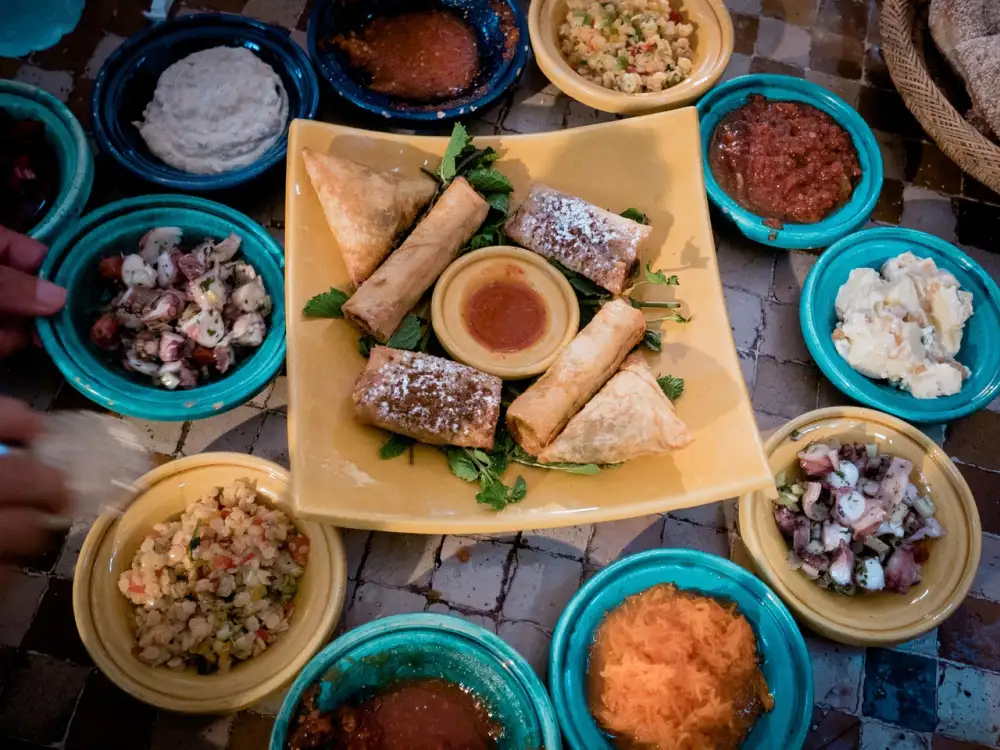Discover the Exquisite Flavors of Moroccan Cuisine: Dive into a Culinary Adventure with Moroccan Food Recipes

- Traditional Moroccan Spices and Ingredients
- Popular Moroccan Dishes and Recipes
- Exploring the Flavors of Moroccan Tagines
- The Art of Making Moroccan Couscous
- Moroccan Street Food: A Culinary Adventure
- Moroccan Desserts: Sweet Delights from North Africa
- Moroccan Tea: A Ritual of Hospitality
- Moroccan Food Culture and Dining Etiquette
- Where to Experience Authentic Moroccan Cuisine
Moroccan cuisine is a vibrant and diverse culinary tradition that reflects the country's rich history and cultural influences. Known for its bold flavors, aromatic spices, and unique combinations of ingredients, Moroccan cuisine offers a truly unforgettable dining experience. From hearty tagines to fragrant couscous dishes, every bite is a journey into the heart of Morocco's culinary heritage. Whether you're a seasoned foodie or just starting to explore new flavors, diving into the world of Moroccan cuisine is sure to be an adventure for your taste buds. So let's embark on this culinary journey and discover the exquisite flavors that await us in Moroccan cuisine.
Traditional Moroccan Spices and Ingredients
Traditional Moroccan cuisine is known for its rich and exotic flavors, which are achieved through the use of a variety of spices and ingredients. Some of the key spices used in Moroccan cooking include cumin, coriander, turmeric, cinnamon, ginger, saffron, and paprika. These spices add depth and complexity to dishes, creating a unique taste that is distinctly Moroccan.
In addition to spices, Moroccan cuisine also relies heavily on fresh herbs such as parsley, cilantro, and mint. These herbs are often used as garnishes or added at the end of cooking to enhance the flavors of the dish.
Moroccan dishes typically feature a combination of meat (such as lamb or chicken), vegetables (such as tomatoes, onions, and peppers), and legumes (such as chickpeas or lentils). The use of preserved lemons and olives is also common in Moroccan cooking, adding a tangy and salty element to many dishes.
Another staple ingredient in Moroccan cuisine is couscous. Made from semolina wheat, couscous is a versatile grain that can be served as a side dish or used as a base for stews and tagines. It has a light texture and absorbs flavors well, making it an essential component in many Moroccan recipes.
Overall, the traditional spices and ingredients used in Moroccan cuisine create a vibrant and aromatic culinary experience. Whether you're indulging in a hearty tagine or savoring the delicate flavors of couscous, each bite will transport you to the colorful streets of Morocco.
Popular Moroccan Dishes and Recipes
Moroccan cuisine is known for its rich flavors and aromatic spices. Some of the most popular dishes include:
1. Couscous: This traditional dish consists of steamed semolina grains served with a variety of vegetables, meat, and flavorful broth.
2. Tagine: A slow-cooked stew made with tender meat (such as lamb or chicken), vegetables, and a blend of spices like cumin, turmeric, and cinnamon.
3. Harira: A hearty soup made with lentils, chickpeas, tomatoes, and various herbs and spices. It is often enjoyed during Ramadan.
4. Pastilla: A savory pie filled with layers of flaky pastry, spiced meat (usually pigeon or chicken), almonds, and dusted with powdered sugar and cinnamon.
5. Mechoui: A succulent roasted lamb dish that is traditionally cooked in a pit underground for hours until it becomes tender and flavorful.
6. Briouats: These crispy pastries are filled with a mixture of ground meat or cheese, herbs, and spices before being deep-fried to perfection.
7. Zaalouk: A smoky eggplant dip made with tomatoes, garlic, olive oil, cumin, paprika, and fresh herbs. It is often served as an appetizer or side dish.
These dishes represent just a fraction of the diverse Moroccan culinary landscape. Each bite offers a tantalizing combination of flavors that will transport you to the vibrant streets of Morocco.
Exploring the Flavors of Moroccan Tagines
Moroccan tagines are a cornerstone of the country's cuisine, known for their rich flavors and tender meats. These slow-cooked stews are traditionally prepared in a clay pot called a tagine, which helps to infuse the ingredients with intense flavors. The combination of spices, herbs, and vegetables creates a unique taste that is both savory and aromatic. Some popular tagine recipes include lamb with apricots, chicken with preserved lemons, and vegetable tagine with couscous. The slow cooking process allows the flavors to meld together, resulting in a dish that is bursting with deliciousness. Whether enjoyed at home or in a Moroccan restaurant, exploring the flavors of Moroccan tagines is sure to be a culinary adventure worth savoring.
The Art of Making Moroccan Couscous
Couscous is a staple in Moroccan cuisine and is considered an art form in itself. Made from semolina wheat, it is a versatile dish that can be served as a main course or as a side dish. The process of making couscous involves steaming the grains to perfection.
To start, the couscous is traditionally hand-rolled into small granules. This labor-intensive process gives the couscous its unique texture and allows it to absorb flavors more effectively. Once rolled, the couscous is then steamed over a simmering pot of stew or broth.
Moroccan couscous is often flavored with an array of spices such as cumin, coriander, turmeric, and cinnamon. It is also common to find vegetables like carrots, zucchini, and onions added to the dish for extra flavor and nutrition.
The result is a fluffy and fragrant mound of couscous that pairs perfectly with slow-cooked meats or vegetable tagines. The delicate texture and rich flavors make Moroccan couscous a true delight for the taste buds.
Whether enjoyed at home or in a traditional Moroccan restaurant, experiencing the art of making couscous is an essential part of any culinary adventure in Morocco.
Moroccan Street Food: A Culinary Adventure
Moroccan street food is a culinary adventure that will tantalize your taste buds and introduce you to the vibrant flavors of Morocco. As you wander through the bustling streets, you'll be greeted by the enticing aromas of sizzling meats, fragrant spices, and freshly baked bread. One popular street food dish is the Moroccan sandwich, known as a "bocadillo." It typically consists of a crusty baguette filled with grilled meat or fish, accompanied by a variety of toppings such as olives, tomatoes, and spicy harissa sauce. Another must-try street food is "msemen," a flaky and buttery pancake that can be stuffed with savory fillings like cheese or minced meat. And don't forget to indulge in some "sfenj," deep-fried doughnuts sprinkled with sugar or dipped in honey. These delectable treats are best enjoyed while strolling through the vibrant markets or sitting at one of the lively outdoor cafes. So grab a napkin and get ready to embark on a mouthwatering journey through the streets of Morocco!
Moroccan Desserts: Sweet Delights from North Africa
No Moroccan meal is complete without indulging in the delectable array of desserts that this North African country has to offer. Moroccan desserts are known for their rich flavors, exotic ingredients, and intricate designs. These sweet treats are a perfect way to end a meal or satisfy your cravings for something sweet.
One popular Moroccan dessert is the traditional Moroccan pastilla. This flaky pastry is filled with a mixture of almonds, sugar, and spices such as cinnamon and nutmeg. It is then dusted with powdered sugar and served warm. The combination of the crispy pastry and the sweet almond filling creates a heavenly taste that will leave you wanting more.
Another must-try dessert is the Moroccan orange cake. Made with fresh oranges, ground almonds, and fragrant orange blossom water, this cake has a moist texture and a refreshing citrus flavor. It is often topped with a drizzle of honey or sprinkled with powdered sugar for an extra touch of sweetness.
For those who love nuts, Moroccan almond cookies are a true delight. These bite-sized cookies are made with ground almonds, sugar, and egg whites. They have a chewy texture and are often flavored with rosewater or orange blossom water. These cookies make for a perfect accompaniment to a cup of Moroccan tea.
If you have a sweet tooth, don't miss out on trying chebakia - deep-fried sesame cookies coated in honey syrup. These twisted cookies are flavored with aromatic spices like anise seeds and cinnamon, giving them an irresistible taste that will leave you craving for more.
Moroccan desserts truly showcase the country's rich culinary heritage and its love for bold flavors and unique combinations. Whether you prefer pastries, cakes, or cookies, there is something to satisfy every sweet craving in Moroccan cuisine.
So next time you find yourself in Morocco or at a Moroccan restaurant, be sure to save room for dessert and indulge in these sweet delights from North Africa. Your taste buds will thank you for the culinary adventure!
Moroccan Tea: A Ritual of Hospitality
Moroccan tea, also known as "Maghrebi mint tea" or "Moroccan mint tea," is not just a beverage; it is a symbol of hospitality and friendship. This traditional drink is an integral part of Moroccan culture and is served on all occasions, from family gatherings to formal events. The preparation of Moroccan tea is an art form in itself, with specific rituals and techniques passed down through generations. The key ingredients are green tea leaves, fresh mint leaves, sugar, and boiling water. The tea leaves are steeped in hot water for a few minutes before adding the mint leaves and sugar. The mixture is then poured back and forth between the teapot and small glasses to create a frothy texture. The pouring process, known as "high pouring," is done from a height to aerate the tea and enhance its flavors. Moroccan tea is enjoyed throughout the day, often accompanied by traditional pastries or nuts. It's not just about the taste; it's about the experience of sharing a cup of tea with loved ones or strangers alike. So next time you visit Morocco, don't forget to indulge in this delightful ritual of hospitality by sipping on a cup of Moroccan mint tea.
Moroccan Food Culture and Dining Etiquette
Moroccan food culture is deeply rooted in tradition and hospitality. Dining in Morocco is not just about the food, but also about the experience. It is common for Moroccans to eat with their hands, using bread as a utensil to scoop up flavorful dishes. Sharing meals with family and friends is an important part of Moroccan culture, and it is customary to offer guests multiple servings of food.
When dining in Morocco, it is polite to accept all offerings of food and drink. It is considered impolite to refuse or waste any food that has been served. In Moroccan culture, eating together signifies unity and connection.
Another important aspect of Moroccan dining etiquette is the use of the right hand for eating. The left hand is traditionally considered unclean and should not be used for handling food. When dining in Morocco, it is also customary to wash your hands before and after the meal.
In Moroccan culture, it is also common to eat from a communal plate or platter. This symbolizes sharing and fosters a sense of community during mealtime. It is polite to take small portions from the shared dish rather than helping yourself to large portions.
Additionally, when dining in Morocco, it is polite to wait for the host or elder to start eating before you begin your meal. This shows respect for the host and their role in providing nourishment.
Overall, Moroccan dining etiquette emphasizes respect, generosity, and community. By embracing these customs while experiencing authentic Moroccan cuisine, you can truly immerse yourself in the rich culinary traditions of this vibrant North African country.
Where to Experience Authentic Moroccan Cuisine
If you're looking to experience the authentic flavors of Moroccan cuisine, there are several places where you can indulge in a culinary adventure. One option is to visit Morocco itself and explore the bustling markets and street food stalls. Cities like Marrakech, Fes, and Casablanca offer a wide range of traditional Moroccan restaurants where you can savor dishes like tagines, couscous, and pastilla.
If traveling to Morocco is not feasible, many cities around the world have Moroccan restaurants that strive to recreate the flavors of this vibrant cuisine. In London, you can find establishments like Momo and Souk Medina that offer an immersive dining experience with authentic Moroccan dishes. New York City is home to renowned restaurants such as Café Mogador and Zerza that transport diners to the streets of Marrakech with their aromatic tagines and flavorful couscous.
For those who prefer a more hands-on experience, attending a cooking class or workshop focused on Moroccan cuisine can be a great way to learn about the flavors and techniques firsthand. Many culinary schools and community centers offer classes where you can master the art of making tagines, rolling couscous by hand, or creating delicate pastries.
No matter where you choose to experience authentic Moroccan cuisine, be prepared for a sensory journey filled with exotic spices, fragrant herbs, and bold flavors that will transport you to the vibrant streets of Morocco.
Published: 01. 12. 2023
Category: Food



